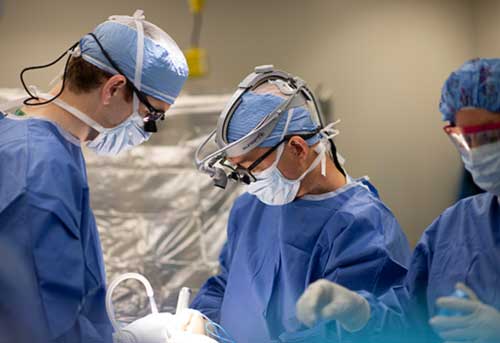Just How Insurance Functions with the Best Spine Surgeons in St Louis MO
Just How Insurance Functions with the Best Spine Surgeons in St Louis MO
Blog Article
A Review of Spine Problems That Often Lead To Surgical Therapies
Back conditions such as herniated discs, spinal constriction, and degenerative disc illness frequently necessitate medical interventions when traditional therapies fail to alleviate relentless signs. Understanding the subtleties of each condition and the equivalent surgical alternatives, such as discectomy or spine fusion, is critical for efficient monitoring.
Herniated Discs
Although several people with herniated discs may locate alleviation via traditional treatments, surgical procedure comes to be a required factor to consider when signs persist or aggravate - best spine surgeons in st louis mo. A herniated disc occurs when the soft internal gel of a back disc extends via its outer layer, possibly pressing neighboring nerves and leading to pain, feeling numb, or weakness in the extremities
Conventional management normally consists of physical therapy, discomfort medicines, and corticosteroid injections, which aim to lower inflammation and enhance feature. In cases where these techniques fall short to alleviate debilitating signs, medical options may be checked out.
One of the most common surgery for herniated discs is a discectomy, which includes the elimination of the herniated section of the disc to alleviate pressure on the impacted nerve origin. In more extreme cases, spine blend may be needed to maintain the impacted vertebrae.
Clients are advised to talk about the potential threats and advantages of surgery with their healthcare company to make a notified choice. Eventually, the objective of any type of surgical intervention is to restore function, alleviate pain, and boost total lifestyle for people experiencing herniated discs.
Spine Stenosis
Spinal stenosis takes place when the rooms within the back slim, causing raised stress on the spine cord and nerves. This condition can develop in various areas of the back, consisting of the lumbar and cervical areas, frequently because of age-related modifications, such as degenerative disc illness, arthritis, or thickening of tendons.
Patients with spinal constriction may provide with symptoms that consist of discomfort, pins and needles, tingling, or weak point, mainly in the legs or arms. These symptoms can be aggravated by tasks that include standing or walking, frequently leading people to look for relief via conventional treatments like physical treatment, medicines, or epidural steroid injections.
Nonetheless, when these non-surgical interventions fail to provide ample relief, surgical choices may be thought about. Typical surgeries for spine constriction consist of laminectomy, which entails the removal of part of the vertebra to minimize pressure, and back fusion, which maintains the afflicted area. The choice to go after surgery is commonly based on the intensity of symptoms, the level of useful impairment, and the general wellness of the client. Motivate diagnosis and administration are critical to avoid more neurological compromise and improve lifestyle.
Spondylolisthesis
Spondylolisthesis happens when one vertebra slides forward over an additional, resulting in imbalance of the back. This condition can arise from various aspects, including genetic problems, trauma, or degenerative modifications in the spine. It is most frequently observed in the lumbar region, especially at the L4-L5 and L5-S1 degrees.

Treatment choices vary based upon the intensity of the slippage and the signs presented. Traditional procedures, including physical therapy, discomfort management, and task adjustment, are my link typically the first line of protection. Nevertheless, when non-surgical methods fall short to eliminate symptoms or when substantial nerve compression is existing, surgical treatment may be called for. Surgical alternatives can include spinal combination or decompression procedures, targeted at recovering placement and minimizing neurological symptoms. Early diagnosis and appropriate monitoring are critical for ideal end results in clients with spondylolisthesis.
Degenerative Disc Illness

The condition can be detected via a combination of medical assessment, imaging studies, and patient background. When these methods fail to give appropriate relief, medical treatments may be taken into consideration.
Surgical alternatives for DDD may consist of spine blend or man-made disc replacement, here are the findings intended at stabilizing the impacted sector and easing pain (best spine surgeons in st louis mo). Eventually, the selection of treatment is embellished, thinking about the intensity of the condition, client wellness, and lifestyle aspects
Spinal Growths

What variables contribute to the development of growths within the spinal column, and just how do they show up in patients? Spinal growths can develop from numerous variables, including genetic tendency, environmental impacts, and pre-existing clinical problems. They can be categorized as primary growths, coming from in the back, or second lumps, which spread out from various other areas of the body. Individuals may offer with a variety of signs and symptoms, including localized pain, neurological shortages, weak point, or modifications in bowel and bladder function, depending on the lump's size and place.
Diagnosis normally includes imaging research studies such as MRI or CT scans, which help mark the growth's attributes and effect on surrounding structures. In assessing therapy options, the lump's quality, place, and kind are vital considerations. Surgical treatment might be warranted to reduce signs and symptoms, acquire a biopsy, or remove visit here the lump entirely. The objective of surgery is commonly to decompress neural elements and support the spinal column. Adjuvant treatments, consisting of radiation or chemotherapy, may additionally be essential depending upon the lump's nature. Early detection and treatment are important for maximizing results in people with spine lumps.
Verdict
In recap, spine conditions such as herniated discs, spine constriction, spondylolisthesis, degenerative disc condition, and spinal growths often demand medical intervention due to their prospective to trigger substantial discomfort and functional disability. While traditional therapies might offer momentary relief, surgical choices come to be critical when signs aggravate or persist. Prompt medical diagnosis and intervention play an essential function in bring back feature and boosting the lifestyle for affected individuals, emphasizing the importance of extensive back care.

Report this page